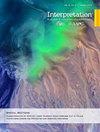利用多波束测深和反向散射改进海底地球化学调查:第1部分,历史回顾、技术描述和最佳实践
IF 1.1
4区 地球科学
Q3 GEOCHEMISTRY & GEOPHYSICS
Interpretation-A Journal of Subsurface Characterization
Pub Date : 2022-12-12
DOI:10.1190/int-2021-0236.1
引用次数: 0
摘要
自古以来,油气渗漏一直是油气勘探的关键工具。自石油工业开始以来,以基础地质和油气渗流识别为重点的全盆地勘察勘探一直是陆上盆地分析的典型内容。自20世纪80年代中期发现海洋化学合成冷泉群落及其与海上石油和天然气渗漏的联系以来,能源行业一直在绘制渗漏图,以针对它们进行勘探,并在开发中避免它们。对于勘探而言,海底石油或天然气的成功采样通过证明生成源岩、成熟度、迁移和充注有关地下石油系统的所有关键数据来降低勘探风险。在海洋环境中,渗漏群落和相关的成岩沉淀物可以改变测深和/或反向散射,并可以通过多波束回声测深(MBES)成像。MBES可以提供详细的海底水深测量;多波束反向散射不仅可以为渗漏采样提供潜在目标,还可以提供海底或海底正下方海底特征的信息;多波束水柱数据可以对海底上升的气体羽流进行成像。多波束在20世纪70年代被引入军事应用之外,多波束在石油和天然气行业的渗透科学中的应用,以及在实时GIS中使用USBL定位的核心来定位渗透,始于20世纪90年代末,2000年进行了第一次专有调查。我们回顾了多波束的历史、渗漏科学的历史,以及几十年来从渗漏探测的最佳实践中吸取的经验教训,从船舶规格到干船坞,从预测量到测量操作再到目标选择。本文章由计算机程序翻译,如有差异,请以英文原文为准。
USE OF MULTIBEAM BATHYMETRY AND BACKSCATTER TO IMPROVE SEABED GEOCHEMICAL SURVEYS: PART 1, HISTORICAL REVIEW, TECHNICAL DESCRIPTION, AND BEST PRACTICES
Oil and gas seeps have been a key tool in hydrocarbon exploration since ancient times. Basin-wide reconnaissance exploration, focused on basic geology and identification of hydrocarbon seepage, has been typical of onshore basin analysis since the beginning of the petroleum industry. Since the discovery of marine chemosynthetic cold seep communities in the mid-1980s, and their association with offshore oil and gas seepage, the energy industry has been mapping seeps both to target them for exploration and avoid them in development. For exploration, the successful sampling of oil or gas at the seafloor reduces exploration risk by demonstrating generative source rock, maturation, migration, and charge all key data about the subsurface petroleum systems. In the marine environment, seep communities and associated diagenetic precipitates can modify the bathymetry and/or the backscatter and can be imaged by Multibeam Echo Sounding (MBES). MBES can provide detailed bathymetry of the seafloor; multibeam backscatter can provide not only potential targets for seep sampling, but information on the seafloor characteristics at or just below the seafloor; and multibeam Water Column data can image gas plumes rising from the seafloor. Multibeam was introduced outside of military applications in the 1970s, with the application of multibeam to seep science in the oil and gas industry, and the use of USBL-positioned cores in a real-time GIS to target seeps, began in the late 1990s, with the first proprietary survey in 2000. We review the history of multibeam, the history of seep science, and lessons learned over decades to best practices in seep hunting, from vessel specification to dry dock to pre-survey to survey operations to target selection.
求助全文
通过发布文献求助,成功后即可免费获取论文全文。
去求助
来源期刊

Interpretation-A Journal of Subsurface Characterization
GEOCHEMISTRY & GEOPHYSICS-
CiteScore
2.50
自引率
8.30%
发文量
126
期刊介绍:
***Jointly published by the American Association of Petroleum Geologists (AAPG) and the Society of Exploration Geophysicists (SEG)***
Interpretation is a new, peer-reviewed journal for advancing the practice of subsurface interpretation.
 求助内容:
求助内容: 应助结果提醒方式:
应助结果提醒方式:


